Output-Based Specifications for PFI/PPP Projects
Output-Based Specifications for PFI/PPP Projects
Output-Based Specifications for PFI/PPP Projects
You also want an ePaper? Increase the reach of your titles
YUMPU automatically turns print PDFs into web optimized ePapers that Google loves.
MOD Private Finance Unit<br />
Guidance Note<br />
<strong>Output</strong>-<strong>Based</strong> <strong>Specifications</strong><br />
<strong>for</strong> <strong>PFI</strong>/<strong>PPP</strong> <strong>Projects</strong><br />
Version 0.2<br />
Consultation Draft<br />
Page 1 of 17<br />
September 2010
© Crown copyright 2010<br />
The text in this document (excluding the departmental logo) may<br />
be reproduced free of charge in any <strong>for</strong>mat or medium providing<br />
that it is reproduced accurately and not used in a misleading<br />
context. The material must be acknowledged as Crown copyright<br />
and the title of the document specified.<br />
MOD PFU Contacts<br />
This document can be found on the MoD PFU website at :<br />
http://www.mod.uk/DefenceInternet/AboutDefence/WhatWeDo/Financea<br />
ndProcurement/PFU/PrivateFinanceUnit.htm<br />
For general enquiries about MOD PFU and its work, contact:<br />
MOD Private Finance Unit Front Desk<br />
Oak 2E, N5, #6228,<br />
MOD Abbey Wood,<br />
Bristol BS34 8JH<br />
Tel: 0117 9132639 (9352 32639)<br />
Email: MODPFU-Front Desk@mod.uk<br />
Page 2 of 17
DOCUMENT CHANGE RECORD<br />
This is a controlled document. Additional copies can be obtained through the issuing<br />
authority. Amendment shall be by whole document replacement. Proposals <strong>for</strong> change<br />
are to be <strong>for</strong>warded to the issuing authority.<br />
Issue<br />
No<br />
Details Of Amendments Made Amended By Date<br />
0.1 Original Draft S Browne Nov 2009<br />
0.2 Second Draft. Minor amendments to reflect feedback from<br />
MOD PFU team.<br />
Page 3 of 17<br />
S Browne Sep 2010
CONTENTS LIST<br />
Introduction........................................................................... 5<br />
Authoritative Guidance ............................................................ 5<br />
What is an <strong>Output</strong>-<strong>Based</strong> Specification?..................................... 5<br />
Use of the <strong>Output</strong>-<strong>Based</strong> Specification ....................................... 7<br />
The <strong>Output</strong>-<strong>Based</strong> Specification as a Contract Obligation ............. 8<br />
Development of the <strong>Output</strong>-<strong>Based</strong> Specification.......................... 9<br />
Page 4 of 17
<strong>Output</strong>-<strong>Based</strong> <strong>Specifications</strong> <strong>for</strong> <strong>PFI</strong>/<strong>PPP</strong><br />
<strong>Projects</strong><br />
Introduction<br />
1. The purpose of this guidance note is to provide acquisition teams<br />
with guidance on the development and preparation of an <strong>Output</strong>-<br />
<strong>Based</strong> Specification (OBS) and the purpose and use of the OBS<br />
throughout the acquisition process.<br />
Authoritative Guidance<br />
2. All <strong>PFI</strong>/<strong>PPP</strong> projects must specify the Authority’s needs in terms of<br />
service outputs. The OBS is the contractual statement of the<br />
Authority’s service requirements that must be defined prior to<br />
<strong>for</strong>mal engagement with industry, <strong>for</strong>ms the basis on which the<br />
bidders prepare their proposals, and against which the Authority<br />
carries out tender evaluation.<br />
3. The OBS must be prepared and drafted in conjunction with the<br />
Payment and Per<strong>for</strong>mance Mechanism (the PPM), the Invitation to<br />
Negotiate and the Tender Evaluation Plan. The OBS along with the<br />
PPM must be aligned to the user’s needs, as expressed in the<br />
Statement of User Need, Key User Requirements (or similar)<br />
What is an <strong>Output</strong>-<strong>Based</strong> Specification?<br />
4. The OBS is solely about the service products, deliverables, or<br />
outputs (hereafter referred to as "outputs") required by the<br />
Authority. The OBS is a statement of ‘what’ is required by the<br />
user; the outputs are what is consumed by the user.<br />
5. The OBS is not a specification of ‘how’ the user’s needs should or<br />
could be met; nor is it a description of the equipment, assets,<br />
infrastructure, facilities and other resources (hereafter referred to<br />
as “inputs”) that the Contractor will need to provide in order to<br />
deliver the output. The OBS should not envisage the solution to the<br />
user’s need nor should it contemplate the inputs that might<br />
constitute the best solution.<br />
6. The OBS should be entirely focused on the use to which the<br />
equipment, assets, infrastructure, and other resources will be put.<br />
For example:<br />
Page 5 of 17
• the provision of a flight simulator does not constitute an output;<br />
the output is the provision of flight simulator sorties to train and<br />
practice flight and emergency procedures in a safe environment<br />
in order that the user can achieve the outcome of qualified and<br />
current aircrew;<br />
• the provision of a single-living accommodation block is not an<br />
output; the output is the provision of accommodation <strong>for</strong> service<br />
personnel to sleep, keep their personal belongings, work/revise,<br />
watch TV and surf the Internet in order that the user can achieve<br />
the outcome of good morale and improved recruitment and<br />
retention;<br />
7. The OBS must also set out the functionality or per<strong>for</strong>mance<br />
characteristics required <strong>for</strong> each output. For example:<br />
• the flight simulator must replicate the flight controls and flying<br />
characteristics of the aircraft and deliver flight simulator sorties<br />
that practice/teach all aircraft flying manoeuvres and<br />
emergencies as detailed in Aircraft Publication (x) and Course<br />
Specification (y);<br />
• the accommodation must include a single bed, a wardrobe, chest<br />
of drawers, bed-side cabinet, an armchair, a desk and office<br />
chair, an Internet connection (2mbs), TV aerial point, telephone<br />
and telephone connection e.t.c. in a floor area of not less that<br />
10m 2 .<br />
8. The <strong>Output</strong> Specification should also identify, at the very highest<br />
level the volume of use <strong>for</strong> each output. For example:<br />
• 2,500 simulator sorties per annum, 48 hours per week and 9<br />
hours per working day between the hours of 0800 hrs to 1800<br />
hrs.<br />
• single living accommodation <strong>for</strong> 100 people per day (1100 hrs to<br />
1100 hrs the following day) <strong>for</strong> 365 days per annum.<br />
9. The OBS will also have to set out the constraints within which<br />
bidders will have to devise their solution, and the eventual<br />
contractor will have to comply during the operation of the service.<br />
These constraints must be kept to an absolute minimum and should<br />
not act as a hindrance to innovation or be a source of unnecessary<br />
cost. This is particularly important if Defence Standards or Military<br />
<strong>Specifications</strong> would normally, in an ‘input-based specification’, be<br />
applicable. Such Defence Standards or Military <strong>Specifications</strong><br />
should not be used if there are equivalent civil standards, or the<br />
purpose of the Defence Standards or Military <strong>Specifications</strong> is to<br />
ensure the quality of the input.<br />
Page 6 of 17
Use of the <strong>Output</strong>-<strong>Based</strong> Specification<br />
10. While the OBS is the statement of the Authority’s requirement, it’s<br />
role and function during the acquisition process varies, and is<br />
supplemented by other project and contract documents as<br />
illustrated in Figure 1 below.<br />
Figure 1 - Illustration of the use of the OBS throughout the acquisition process<br />
11. In the early stages of the acquisition the principal purpose of the<br />
OBS is to:<br />
• translate the Statement of User Need at the system/capability<br />
level into a contractual statement of the Authority’s requirement<br />
<strong>for</strong> the contract;<br />
• <strong>for</strong>m the basis <strong>for</strong> the development of the contractual terms and<br />
conditions, in particular the PPM;<br />
• in<strong>for</strong>m potential bidders as to the scope, boundaries and<br />
constraints of the contract;<br />
12. During the tendering stages the OBS is, in essence, a top-level<br />
design-brief against which bidders will develop their proposals. The<br />
Authority will also have to provide instructions to bidders on the<br />
preparation, scope and content of their proposals, as well as the<br />
evaluation criteria the Authority will use to assess the bids.<br />
13. During the Authority’s evaluation of bids, the OBS becomes the<br />
benchmark to evaluate bidders’ solutions.<br />
14. Once the contract is awarded the OBS then becomes the<br />
Contractor’s principal obligation (normally at Schedule A of the<br />
Page 7 of 17
Contract), supplemented by the incorporation of the winning<br />
bidder’s proposal (now the Contractor’s Proposal, normally at<br />
Schedule B of the Contract) as a clear and unequivacal statement<br />
as to how they will meet the requirement.<br />
The <strong>Output</strong>-<strong>Based</strong> Specification as a Contract Obligation<br />
15. The position of the OBS in the Contract is illustrated at Figure 2<br />
below.<br />
Figure 2 - Contract Order of Precedence<br />
16. The effect of this order of precedence is that even if the Contractor<br />
successfully delivers the inputs in accordance with the Contractor’s<br />
Proposal, but fails to satisfy the requirements of the OBS, then the<br />
Contractor will be in contractual default and the remedies in the<br />
PPM will apply.<br />
17. This is further rein<strong>for</strong>ced by other provisions of the Contract<br />
whereby:<br />
• The Contractor warrants that his proposal will meet the<br />
requirements of the OBS;<br />
• The Authority does not ‘accept’ that the inputs have been<br />
delivered in accordance with the Contractor’s proposal, but<br />
Page 8 of 17
merely certifies that payment should commence when the<br />
construction and commissioning of the inputs has been<br />
completed;<br />
• Under the PPM, the Authority only makes payment <strong>for</strong> the<br />
delivery of outputs, rather than the provision of the inputs, and<br />
either pays on each and every occasion when the output is<br />
delivered or pays <strong>for</strong> the availability of outputs, and levies<br />
deductions (remedies) when the output is not delivered or is not<br />
available when required in accordance with the OBS.<br />
Development of the <strong>Output</strong>-<strong>Based</strong> Specification<br />
18. There are five distinct phases to the development of the OBS along<br />
with the supplementary project and contract documents through the<br />
acquisition process.<br />
19. Stage 1 – Strategic Level<br />
• The strategic level of the OBS should be developed at the same<br />
time as the business case <strong>for</strong> the down-selection of the<br />
Procurement Strategy. The focus should be on the development<br />
of the top-level outputs required from the Contractor based upon<br />
the Key User Requirements.<br />
• It should define <strong>for</strong> each top-level output 'what' is required, and<br />
its function and purpose from the user's perspective. The level<br />
of detail does not need to be any greater than the Key User<br />
Requirements that it is intended to address. It must however,<br />
clearly identify the outputs that the eventual Contractor is<br />
required to deliver, the interface points with any other Authority<br />
assets/equipment/infrastructure, and any strategic constraints<br />
and assumptions.<br />
• It is also essential that the strategic level of the OBS defines the<br />
‘service boundary’ <strong>for</strong> the contract; the lines of responsibility<br />
between the Authority and the Contractor. A pictorial summary<br />
of a service boundary is shown at Figure 3 below.<br />
• It is important that the strategic level of the OBS is sufficiently<br />
matured and agreed with the User be<strong>for</strong>e embarking on any<br />
further development of the OBS.<br />
• Once the strategic level of the OBS is matured and agreed it can<br />
<strong>for</strong>m the basis of early engagement with industry in the <strong>for</strong>m of<br />
market soundings and industry days.<br />
Page 9 of 17
Figure 3 – Pictorial Summary of a Service Boundary<br />
20. Stage 2 – Definition of <strong>Output</strong> Per<strong>for</strong>mance Standards and<br />
Service Levels<br />
• This stage of development of the OBS should be carried out in<br />
conjunction with the development of the PPM.<br />
• This stage involves the definition of the functional per<strong>for</strong>mance<br />
and service levels of each output that crosses the service<br />
boundary. This must include volume requirements and quality<br />
standards, <strong>for</strong> example:<br />
− how many/how much of the output is required;<br />
− how often/when is it required;<br />
− what are the minimum per<strong>for</strong>mance/standards of the output.<br />
• For both the OBS and the PPM, the key questions that will need<br />
to be answered are:<br />
− is the level of per<strong>for</strong>mance specified in the OBS sufficient to<br />
enable the user to achieve the desired outcome;<br />
− what level of poor per<strong>for</strong>mance would cause the user<br />
Page 10 of 17
inconvenience;<br />
− what level of poor per<strong>for</strong>mance would cause the user to incur<br />
additional costs (i.e. in waiting time/queuing/finding<br />
alternative sources of supply);<br />
− what level of poor per<strong>for</strong>mance would constitute non-delivery<br />
of the output when required by the Authority;<br />
− what level of poor per<strong>for</strong>mance would constitute the nonavailability<br />
of the service when required by the Authority;<br />
− what level of poor per<strong>for</strong>mance would constitute a critical<br />
failure to the achievement of the user's desired outcome.<br />
− how will poor per<strong>for</strong>mance be identified/detected;<br />
− how will the levels of per<strong>for</strong>mance be monitored and<br />
measured;<br />
− does the OBS specify the level of per<strong>for</strong>mance and standard<br />
of service in an unambiguous and objective manner;<br />
− is the method of monitoring and measurement, and the<br />
mechanics of the PPM capable of drawing a distinction<br />
between the differing levels of poor per<strong>for</strong>mance;<br />
− are the outputs (or the failure to deliver the outputs)<br />
incentivised in accordance with their impact on the user and<br />
the achievement of the customer’s desired outcome.<br />
• It is particularly important at this stage to consider how the user<br />
will make use each output.<br />
− For some outputs, the Authority will need to make a specific<br />
demand <strong>for</strong> the delivery of the output, such as the use of a<br />
simulator sortie or an air-to-air refuelling sortie.<br />
− Other outputs will be used on a largely continuous or ad hoc<br />
basis, such as access to accommodation facilities or<br />
computer-based training.<br />
• The per<strong>for</strong>mance and service level requirements will need to be<br />
tailored to the method use of the output:<br />
− whether the output was delivered as requested; and<br />
− whether the outputs were available <strong>for</strong> their intended use<br />
when required.<br />
Page 11 of 17
21. Stage 3 – Definition of the Technical Evaluation Criteria<br />
• Once the OBS is sufficiently developed the acquisition team will<br />
need to consider the tender evaluation criteria <strong>for</strong> the bidders’<br />
proposals and prepare the technical aspects of the tender<br />
evaluation plan.<br />
• The evaluation of the bidders’ proposals will need to consider:<br />
− whether the bidder proposes to fully or partially meet the<br />
requirements of the OBS;<br />
− whether the bidder’s proposed inputs are likely to satisfy the<br />
requirements of the OBS; and<br />
− whether the bidder is likely to be able to deliver the proposed<br />
inputs.<br />
• The evaluation will there<strong>for</strong>e need to include an evaluation of:<br />
− the impact on the user of any stated non-compliance and its<br />
effect on the achievement of the desired outcome;<br />
− the level of confidence that the proposed inputs will deliver<br />
the required outputs;<br />
− the level of confidence that the bidder can project manage<br />
and carry out the design, construction and commissioning of<br />
the proposed assets, equipment and infrastructure;<br />
− The level of confidence that the bidder can manage,<br />
administer, and integrate the proposed inputs in order to<br />
deliver the outputs.<br />
• The evaluation criteria will there<strong>for</strong>e need to consider not only<br />
the inputs proposed by the bidder, but also the bidders’<br />
competence to deliver and implement them. The key test as to<br />
whether the evaluation criteria is appropriate, will be whether it<br />
appropriately assesses and differentiate between circumstances<br />
such as:<br />
− The bidder proposes to meet the OBS, but the inputs are<br />
evaluated as being unlikely to deliver the outputs;<br />
− The bidder proposes to meet the OBS with inputs that are<br />
likely to deliver the outputs, but there are flaws in the<br />
bidder’s project management planning and/or plan <strong>for</strong> the<br />
management, administration, and integration of the proposed<br />
solution.<br />
Page 12 of 17
22. Stage 4 – The Definition of the Scope and Content of the<br />
Bidder’s Proposal<br />
• The principal purpose of the bidders’ proposal is to describe how<br />
they will meet the OBS and define the inputs that will deliver the<br />
outputs.<br />
• However, based on the evaluation criteria defined in Stage 3,<br />
and given that the bidder’s proposal is intended to be<br />
incorporated into the Contract it is sometimes useful to require<br />
that bidders submit their proposals in two parts:<br />
− the first to define the solution and provide a functional<br />
specification of the inputs to satisfy the OBS that will <strong>for</strong>m<br />
part of the Contract (hereafter referred to as the “Input<br />
Specification”); and<br />
− secondly, the evidence of the bidder’s competence, skill and<br />
experience to deliver and implement the proposed solution<br />
and inputs that will be used <strong>for</strong> the purposes of evaluation<br />
only (hereafter referred to as the “Supporting Evidence”).<br />
• The Input Specification should as a minimum require that bidders<br />
propose:<br />
− An OBS Compliance Matrix that confirms whether or not their<br />
proposal meets the per<strong>for</strong>mance standards and service levels<br />
<strong>for</strong> each output defined in the OBS, and identifies any<br />
shortfalls or limitations in their achievement.<br />
− A top-level description of the inputs that are proposed and<br />
how they contribute to the delivery of the outputs. This<br />
should include a clear picture of what inputs contribute to the<br />
delivery of which outputs;<br />
− A technical specification of each input that:<br />
� describes the physical (qualitative and quantitative)<br />
per<strong>for</strong>mance characteristics of the input;<br />
� describes how the physical and per<strong>for</strong>mance characteristics<br />
of the input enables the input to contribute to the delivery<br />
of the output.<br />
− A description as to how any constraints specified in the OBS<br />
will be complied with.<br />
− A specification of any Government Furnished Assets (GFA)<br />
that is required to be provided by the Authority (either<br />
Page 13 of 17
directly or from other Authority Contractors) including:<br />
� how many/how much of the GFA is required;<br />
� how often/when is it required<br />
� what is the minimum per<strong>for</strong>mance/quality standards of the<br />
GFA.<br />
− For the bidder’s proposed solution (as a whole) bidders should<br />
also provide details of the processes, tools and deliverables<br />
that:<br />
� they would use to manage, administer and integrate the<br />
inputs to deliver the outputs;<br />
� the user of the outputs would be expected to interface with<br />
in order to book and schedule the use of the outputs;<br />
� they would use to enable the monitoring and measurement<br />
of service delivery and per<strong>for</strong>mance;<br />
� they would use to demonstrate compliance with the OBS<br />
and obligations of the contract.<br />
• The Supporting Evidence required from the bidders might<br />
include:<br />
− The bidder’s requirement analysis showing how they derived<br />
their solution to the OBS and the physical and per<strong>for</strong>mance<br />
characteristics of the input in order to ascertain the validity of<br />
the bidders solution and their understanding of the<br />
requirements of the OBS 1 ;<br />
− The bidder’s project management plan <strong>for</strong> the design,<br />
development, construction and certification of the inputs;<br />
− The bidder’s risk management plan and risk register <strong>for</strong> both<br />
the Pre-Operational and Operational phases of the Contract<br />
with particular attention to risk mitigation and fallback plans;<br />
− The bidder’s logistic support analysis of the assets, equipment<br />
and infrastructure and how the design and the logistic support<br />
of the equipment and infrastructure will deliver the planned<br />
level of availability;<br />
− a Technology Readiness/System Integration Readiness Level<br />
1<br />
For construction and works project this might include evidence to support the Design<br />
Excellence Evaluation Process<br />
Page 14 of 17
Assessment <strong>for</strong> any solution or input that includes new<br />
technology, new products or new systems;<br />
− evidence that the bidder (or its proposed sub-contractors) has<br />
the experience or competence to deliver and implement the<br />
proposed solution 2<br />
23. Stage 5 – Finalising the OBS and the Bidder’s Proposal <strong>for</strong><br />
Contract Award<br />
• Prior to Contract Award the OBS will need to be updated to<br />
reflect the bidder’s proposal in respect of any non-compliance,<br />
limitation, or restriction on the achievement of the per<strong>for</strong>mance<br />
standard and service levels. Any such changes must only be<br />
accepted with extreme care and acquisition teams need to<br />
consider:<br />
− Whether the change constitutes a material change to the<br />
Authority’s requirement such that they are outside the scope<br />
of the original procurement adverts and there<strong>for</strong>e will need to<br />
re-competed;<br />
− Whether the change to the OBS is solution specific (i.e. is<br />
specific to one bidders’ proprietary solution) or is a change<br />
that should be made to the OBS <strong>for</strong> all bidders in order to<br />
maintain and level playing field between the bidders;<br />
− The impact of the change on the end-user and the<br />
achievement of the Statement of User Need or Key User<br />
Requirements;<br />
• The Input Specification in the Bidders’ Proposal should be<br />
amended to reflect the outcome of any clarification or<br />
negotiation. Acquisition teams should also confirm that the<br />
description of the inputs fully reflects the basis on which the<br />
Authority has made its evaluation decision. For example, if the<br />
Authority regards bidder A’s solution to be more environmentally<br />
sustainable because he has proposed to use photovoltaic panels<br />
to supplement mains electricity, then this must be reflected in<br />
the Input Specification that will go on to be included in the<br />
Contract.<br />
• The Supplementary Evidence in the Bidders’ Proposal will only<br />
need to be updated to ensure that the evidence on which the<br />
Authority makes its evaluation decision is documented and<br />
auditable.<br />
2 This would be more detailed and solution specific when compared with the technical<br />
evaluation carried out as part of the Pre-Qualification Questionnaire<br />
Page 15 of 17
• Acquisition teams should also prepare, as part of the final bid<br />
evaluation reports, a requirements traceability matrix that shows<br />
how the requirements in the Statement of User Need or Key User<br />
Requirement are reflected in the OBS and are then satisfied by<br />
the Input Specification in the Bidders’ Proposal.<br />
Page 16 of 17
End Page<br />
Page 17 of 17



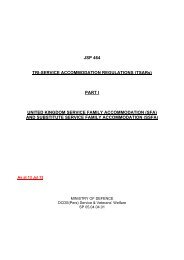
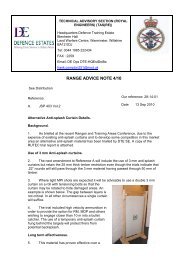

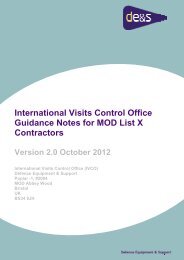
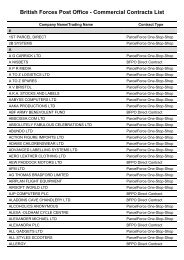

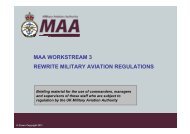

![MAA Regulatory Publications - FAQs PDF [37.3 KB]](https://img.yumpu.com/5906104/1/184x260/maa-regulatory-publications-faqs-pdf-373-kb.jpg?quality=85)
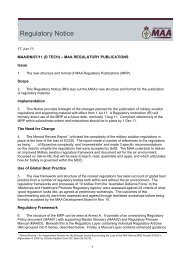
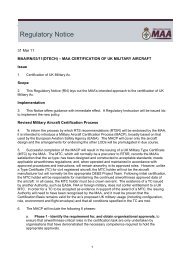
![3750 edition 6 PDF [263.5 KB] - Ministry of Defence](https://img.yumpu.com/5901071/1/184x260/3750-edition-6-pdf-2635-kb-ministry-of-defence.jpg?quality=85)

